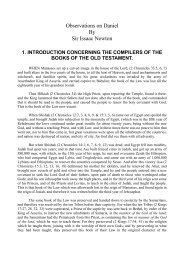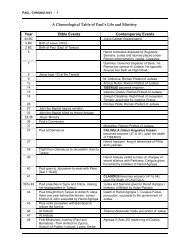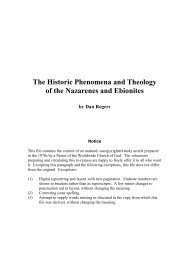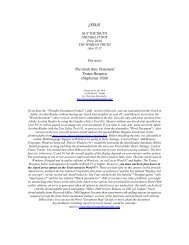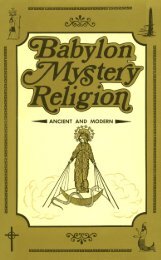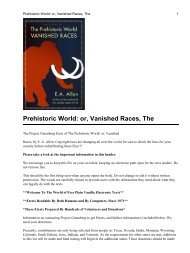Legends of the Shawangunk2 JR.pdf - Friends of the Sabbath ...
Legends of the Shawangunk2 JR.pdf - Friends of the Sabbath ...
Legends of the Shawangunk2 JR.pdf - Friends of the Sabbath ...
You also want an ePaper? Increase the reach of your titles
YUMPU automatically turns print PDFs into web optimized ePapers that Google loves.
Early Settlers <strong>of</strong> <strong>the</strong> Shawangunk Region. 123<br />
<strong>the</strong>re was a panic among <strong>the</strong> women and children; but it was quickly remedied when <strong>the</strong><br />
strong arms <strong>of</strong> <strong>the</strong> men came to <strong>the</strong> rescue. They were obliged to leave one sleigh load in<br />
<strong>the</strong> woods, where <strong>the</strong> goods remained until <strong>the</strong> men returned and carried <strong>the</strong>m on <strong>the</strong>ir<br />
backs to <strong>the</strong>ir destination. At this time <strong>the</strong>re was no house in Monticello, nor even a line<br />
<strong>of</strong> marked trees to that point.<br />
The dwellings <strong>of</strong> <strong>the</strong>se settlers were very primitive structures, built <strong>of</strong> logs with bark<br />
ro<strong>of</strong>s. The floors—as soon as <strong>the</strong>y could afford that luxury—were made by splitting logs<br />
in half, and laying <strong>the</strong> flat side uppermost. The fireplaces were commodious affairs,<br />
without jambs, into which a back-log ten feet in length could be rolled. For windows<br />
<strong>the</strong>y at first used paper, previously rubbed with hog’s lard—a kind <strong>of</strong> glazing that shed a<br />
most beautiful light when <strong>the</strong> sun shone on it. The chimneys were made <strong>of</strong> stones<br />
plastered with mud; <strong>the</strong> same primitive cement was used in stopping up <strong>the</strong> chinks<br />
between <strong>the</strong> logs. When <strong>the</strong> room was lighted up <strong>of</strong> an evening by <strong>the</strong> glowing fire<br />
extending nearly across one side <strong>of</strong> <strong>the</strong> house, <strong>the</strong>re was an air <strong>of</strong> comfort within <strong>the</strong><br />
interior <strong>of</strong> that log-cabin that is not to be found in <strong>the</strong> most sumptuous apartment. And<br />
when to <strong>the</strong> music <strong>of</strong> <strong>the</strong> winds in <strong>the</strong> tall pines that grew by <strong>the</strong> door, <strong>the</strong>re are added <strong>the</strong><br />
lonely howl <strong>of</strong> <strong>the</strong> wolf and <strong>the</strong> scream <strong>of</strong> <strong>the</strong> pan<strong>the</strong>r, while within all was safe and snug,<br />
with <strong>the</strong> children sweetly sleeping in <strong>the</strong>ir cots—<strong>the</strong> picture is complete.<br />
There was no cellar under <strong>the</strong> floor. Potatoes and o<strong>the</strong>r vegetables were stored in<br />
holes or dirt-cellars close by <strong>the</strong> house. A mound <strong>of</strong> earth was heaped over <strong>the</strong>se<br />
depositories, and it seems <strong>the</strong>se mounds were a favorite resort for wolves. Fifty years<br />
afterwards <strong>the</strong> wife <strong>of</strong> Nehemiah Smith used to tell <strong>of</strong> having seen <strong>the</strong>m <strong>the</strong>re, at night,<br />
when <strong>the</strong> moon made <strong>the</strong>m visible. These animals were a source <strong>of</strong> great terror to <strong>the</strong><br />
women and children, and <strong>the</strong>ir howlings were generally continued long into <strong>the</strong> night.<br />
Sheep were a necessity, as <strong>the</strong>ir wool was <strong>the</strong> chief reliance <strong>of</strong> <strong>the</strong> settlers for winter<br />
clothing; but it was impossible to keep <strong>the</strong>m unless <strong>the</strong>y were put into a safe enclosure<br />
every eight. A single wolf would destroy a whole flock in a few minutes, its instinct<br />
leading it to rush from one victim to ano<strong>the</strong>r, giving each a snap in <strong>the</strong> throat, which was<br />
always fatal.<br />
The bedsteads were made in <strong>the</strong> most primitive way, with but a single post—let all<br />
who believe that four posts are essential take notice—holes bored into <strong>the</strong> logs <strong>of</strong> <strong>the</strong><br />
apartment serving <strong>the</strong> purpose <strong>of</strong> <strong>the</strong> missing legs. A bit <strong>of</strong> clapboard, riven from <strong>the</strong> red<br />
oak, supported on wooden pins driven into <strong>the</strong> wall, contained <strong>the</strong> pewter dishes and<br />
spoons. The spinning wheel was an essential adjunct to <strong>the</strong> family outfit, while a few<br />
chairs, some pots and kettles, and an eight-by-ten looking-glass completed <strong>the</strong> furniture.<br />
A majority <strong>of</strong> <strong>the</strong> inhabitants <strong>of</strong> this period were <strong>of</strong> upright characters, bold,<br />
energetic, and generous-hearted. Although subject to privations, <strong>the</strong>ir lot in life, as a<br />
whole, was not an unhappy one. Said one <strong>of</strong> <strong>the</strong>m: “When I look back upon <strong>the</strong> first few<br />
years <strong>of</strong> our residence in <strong>the</strong> wilderness, I am led to exclaim, Oh, happy days <strong>of</strong> primitive<br />
simplicity! What little aristocratic



